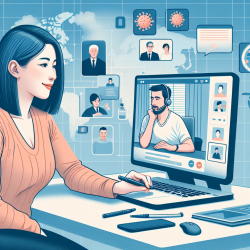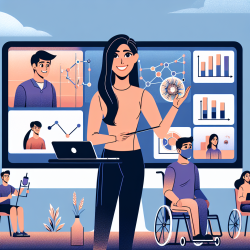Introduction
The advent of telehealth has transformed the landscape of healthcare delivery, offering innovative solutions to overcome geographical and socioeconomic barriers. In the realm of speech-language pathology, tele-dysphagia—a subset of telehealth focusing on dysphagia therapy—has emerged as a promising avenue for delivering care to individuals with swallowing disorders. This blog delves into the findings of the research article "Case Reports: Trial Dysphagia Interventions Conducted via Telehealth" and explores how practitioners can enhance their skills by integrating these insights into their practice.
Understanding Dysphagia and Tele-Dysphagia
Dysphagia, characterized by difficulty in swallowing, poses significant health risks, including aspiration pneumonia. It is particularly prevalent among the geriatric population, with an estimated 40-60% of institutionalized elderly individuals affected. Traditional dysphagia therapy, primarily delivered in-person, faces challenges in accessibility, especially in rural and socioeconomically disadvantaged areas. Tele-dysphagia offers a potential solution by utilizing telecommunications technology to deliver therapy remotely.
Research Insights
The study under discussion presents three case reports of individuals who participated in trial tele-dysphagia therapy sessions. The participants, diagnosed with dysphagia, engaged in therapy sessions via telehealth platforms, employing strategies such as cyclic ingestion, chin down, and head rotation to enhance swallowing safety. The study's findings suggest that tele-dysphagia can effectively achieve therapy goals comparable to in-person sessions.
Practical Applications for Practitioners
For practitioners aiming to incorporate tele-dysphagia into their practice, the study offers several actionable insights:
- Adopt Telehealth Platforms: Utilize HIPAA-compliant telehealth applications like VSee to ensure patient confidentiality and facilitate real-time interactions.
- Implement Evidence-Based Strategies: Incorporate swallowing safety strategies such as cyclic ingestion, chin down, and head rotation, which have demonstrated efficacy in minimizing aspiration risk.
- Conduct Rigorous Assessments: Perform thorough clinical assessments to tailor interventions to individual patient needs, ensuring the effectiveness of tele-dysphagia sessions.
- Engage in Continuous Learning: Stay informed about emerging research in tele-dysphagia to refine therapeutic approaches and improve patient outcomes.
Encouraging Further Research
While the study provides preliminary evidence supporting the efficacy of tele-dysphagia, it also highlights the need for further research. Future studies should focus on larger sample sizes, diverse populations, and long-term benefits to validate and expand upon these findings. By contributing to the growing body of evidence, practitioners can play a pivotal role in advancing the field of tele-dysphagia.
Conclusion
The integration of tele-dysphagia into clinical practice holds great promise for enhancing access to dysphagia therapy and improving patient outcomes. By leveraging the insights from the research article, practitioners can refine their skills and contribute to the evolution of telehealth in speech-language pathology. To explore the original research paper, please follow this link: Case Reports: Trial Dysphagia Interventions Conducted via Telehealth.










